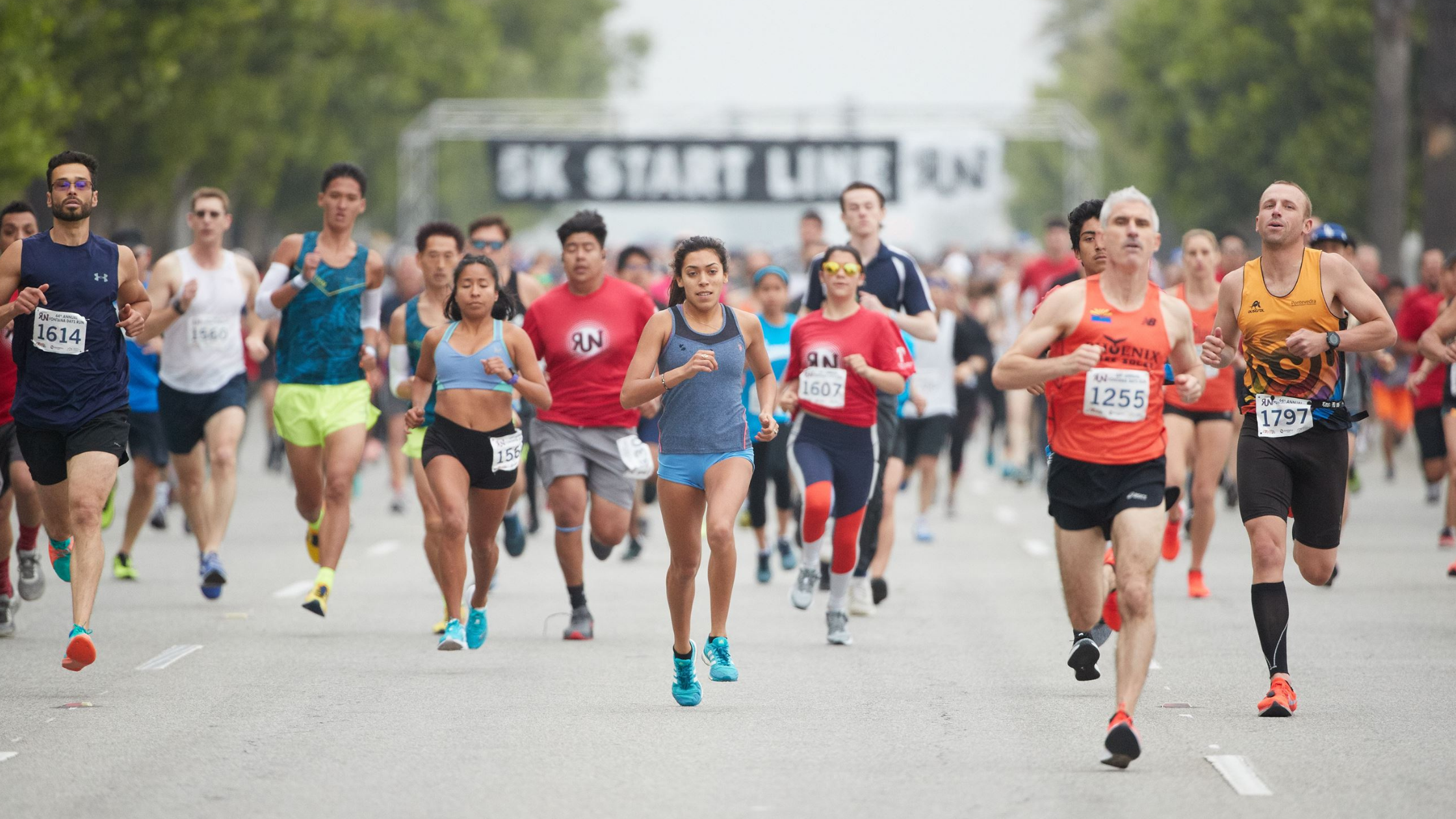Learn how to train for the iconic 5k race and find out what strategy you need to race a 5k at your highest level. No couch required. Click here to listen to the podcast version of this post.
One of the most popular race distances out there for recreational and professional runners alike is the 5k. A 5k race is 3.1 miles long and if you live in any decently-sized town or city in the United States, you could find a 5k race just about every weekend, especially in the nice-weather months.

Why Five Kilometers?
Part of the reason they are so popular is because they are so accessible. Most people can walk three miles and most relatively fit people can run 3 miles, so the 5k is a fund raiser’s dream race distance. If you are just starting to get in shape, a 5k is an admirable and achievable goal and a great way to showcase your newfound fitness.
More seasoned runners show up at 5k races to test their skills, polish up their speed, or to get a hard workout in with thousands of their closest friends in the middle of their marathon training. The beauty of a 5k for these runners is that it’s long enough to still be highly aerobic, yet short enough to really crank down some speed. And unlike a marathon, racing a 5k won’t leave you walking funny for the next several days, meaning you can slip in 5ks almost as much as you like in a marathon build up without missing a beat of training with extra recovery days.
So if you’d like to race a 5k, I’ll outline some training and racing techniques that will help you turn in your best performance yet.
So what exactly is a “Fast” 5K?
The 5k or 5000 meter race has been around since at least 1897. As of this writing the men’s world record is held by Ugandan Joshua Cheptegei in 12:35 in 2020 and the women’s world record is 14:00, run by Ethiopian Gudaf Tsegay in 2023. It’s doubtful that any of the tape breakers at your local Turkey Trot will come anywhere close to these blisteringly fast paces, but it’s fun to dream isn’t it?
So what’s considered “fast” for a 5K for a mere mortal?
Well, if you are walking a 5k, that would take you somewhere around 45 to 60 minutes to complete.
Most recreational runners would be pretty happy with a 25-minute 5k or less which is 5 minutes per kilometer or about an 8:00/mile. Front-of-the-pack non-elite runners tend to cross the line under 20 minutes while professional runners are in the 15 minute range for women and the 13 to 14 minute range for men.
The great thing about the 5k is that it’s a really challenging distance on its own, but it’s also a fantastic practice race for other distances. If you love the marathon, for example, spending some serious time in between marathon cycles training for the 5k will certainly help you improve your marathon time. It’s also a refreshing break from the long grind of marathon training.
A 5k-Specific Training Cycle
All runners training for a 5k need to remember that even though it’s a relatively short race, it’s still highly aerobic. Aerobic means that you are using oxygen to unlock the fuel in your cells to move your muscles. The way you build a big aerobic engine is lots of slow running or even walking.
Now when I say “lots of slow running,” that’s relative to your experience and fitness. If you’ve never run before, popping out the door for a 3 mile jog will land you right back where you started–on the couch.
But for an every day runner 3 miles a day might be your sweet spot or might not be much at all. Again, the details depend on where you are starting from, but the advice is the same–spend most of your training staying in the aerobic zone, where you can talk easily but you are still moving your body.
Beginners
If you are a brand new runner and you are not coming from another sport, just covering the distance of three miles could be a lot for you and that’s okay. We all start somewhere.
For these runners, I recommend a run/walk program. So you might walk for 5 minutes as your warm up, then run for two minutes, and then walk for 2 minutes. You could repeat this sequence for 20 or 30 minutes and then finish with a walk to cool down. Then on day 2, I recommend resting or just walking. On day 3, try adding a minute to your run segments. Then the next day, rest or just walk.
After a couple of weeks, you could be fit enough to lengthen your runs into miles instead of minutes, always making sure that you are recovering well between workouts to build up your muscles and prevent injury. If you are sore or extra tired, give yourself an extra rest day or go back to a run/walk sequence.
Eventually, you’ll be able to run three miles in training and if you like, you can go ahead and sign up for your first 5k to see what the race experience is like.
Once you are comfortable with the distance, you’ll want to work on your speed. And more specifically than just raw speed, you want to work on your stamina, which is the combination of speed and endurance.
You could go out to your local track and bust out some short repeats as fast as you can and a lot of people do this. High effort, intense intervals will help you sharpen your raw speed, but they don’t give you what you really need, which is the ability to sustain your speed over 3.1 miles. So for that, we need to get specific for about 6 weeks or so.
The Workouts
A perfect workout to prepare specifically for the 5k is 12 repeats of 400 meters or a quarter mile at your goal 5k pace with a short, but relatively quick jogging rest of 100m. No stopping or walking if you can help it.
If you don’t know what your goal pace is, try to pick a pace that would be a medium-hard effort for a quarter mile, but nowhere near all out, perhaps a 6 or a 7 on a scale of 1-10. You want to find a speed you can sustain the whole workout without burning out, and still be able to keep those jog breaks honest.
By not fully recovering and jogging quickly between repeats you still improve your ability to run at race pace, but you ensure you have the aerobic strength and support to maintain goal pace on race day.
The next week is 6×800, so now you are up to a half mile at a time at goal pace.
By week 6, you should be just about ready to race that weekend. We want to keep your legs sharp by including some speed about 5 days ahead of the race, but not so much that you are tired on race day.
Race Week
A good race week workout could be a mile at faster than 5k goal pace, rest for 3-5 minutes, and then a couple of 400s faster than race pace. While going faster than goal pace seems counterintuitive, your fitness is already built by now and you are just reinforcing the connection between your brain and your legs for this one. The other reason faster than goal is good here is because it makes your real goal pace feel way more comfortable!
Intermediate and Advanced
If you are a more advanced runner, you can probably handle more reps than what I’ve outlined, but the structure is exactly the same–chop up the 5k into little pieces separated by short, quick jogs.
Of course all of the workouts I’ve just described include a good warm up and cool down of nice and easy running of a length that’s appropriate for your experience.
Outside of Running
And also no runner’s training would be complete without proper rest and recovery as well as just enough strength training to keep the body strong and injury-free.
After weeks of training race day arrives. What’s the best way to race it?
5k Race Strategy
The 5k has the reputation of being a lung-searing, quad-burning race where you start fast, stay fast in the middle, and speed up towards the end. And that’s pretty much exactly the strategy for racing it.
As with all endurance races, running negative splits or finishing faster than you started is the recommended strategy for most 5k courses. If you are running it hard, it will hurt, but thankfully it’s over quickly and you can be recovered enough to race it again next weekend.
Warm Up
But before we even get into 5k race strategy, be sure that you spend some time warming up right before the race. Of course you don’t want to leave your speed in the warm up so you are tired at the starting line, but you’ll want to spend a good 15-20 minutes or so doing an easy jog and then about 5-10 minutes doing some speed drills to wake the legs up.
One Mile at a Time
Now that your legs are warm, I like to break the 5k up into miles. When the gun goes off, you’ll be tempted to blast off the line as fast as you can. Don’t do that. While you definitely don’t want to run slowly the first mile, if you’re running your goal pace right away, it will catch up with you quickly. There’s simply not enough time in a 5k to do much pace correction if you use up all your gas in the first mile.
So let’s call the first mile a “controlled, but sustainable effort.” You should feel like even if everything goes wrong, you can handle this pace the entire time.
As you begin the second mile, your goal should be to pick up the pace even more. Again, this still needs to be a controlled effort because you have a long way to go, but this is where you put your feet to the fire, just a little bit.
By mile 3, you’ve got to decide whether or not you can give more or if you just need to hang on for dear life. This will feel like the longest mile of the whole race, but if you’ve rationed out your effort just right, it will be the quickest. Don’t go for broke right away, but it’s about time to accept that everything is feeling harder and harder and the best way to feel better is to get to that finish line as quickly as you can.
When you get to the home stretch, your heart should be pounding, your face should be burning red and you are pumping your arms and legs as fast as they possibly can go. You might be taking a breath with every step, which is borderline hyperventilating, but if you can just get to the end with everything you’ve got, it will all be worth it.
You Did It!
In my opinion, racing a 5k to the best of your ability is even harder than running a great marathon. Yes, it’s over a lot sooner, but the level of intensity is arguably 10 times higher. I personally prefer the slow simmer of the marathon to the burning fire of the 5k, but racing the 5k definitely made me a better marathoner.
And the best part? If you don’t get the results you want, the recovery is short enough from a 5k race that you can try again next weekend.

